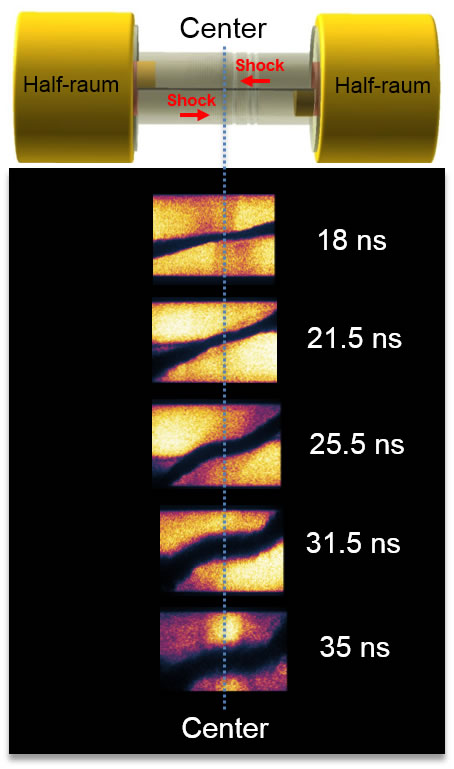Efficiency Improvements - 2017
April
NIF’s Shot Efficiency Helps ‘Shear’ Experiments Reach Their Goal
An important experimental campaign on NIF has been successfully completed, producing meaningful results that will help guide future experiments, thanks in part to the NIF Team’s dedicated efforts to boost the facility’s shot rate through efficiency improvements.
Led by Los Alamos National Laboratory (LANL) researchers, the “shear” campaign was designed to enhance computer models of turbulent mix in high energy density (HED) and inertial confinement fusion (ICF) experiments (see “‘Shock/Shear’ Experiments Shed Light on Turbulent Mix”).
Mixing of target capsule material with fusion fuel due to hydrodynamic instabilities is a significant concern for ICF researchers, who believe it could be interfering with NIF’s implosion performance. Data from the experimental campaign is fed into the models to further researchers’ understanding of the role of mix and its effect on energy yield and ultimately, on NIF’s ability to achieve ignition.
 A select five-image sequence of radiographs from the final set of NIF shear experiments. NIF fired 300 kilojoules of laser energy at each end of a shock-tube target comprised of two half-hohlraums (top image) to produce 100-meters-per-second shock waves from opposite ends of a foam-filled shock tube. These waves turned the foam into plasma as the shocks traveled through the foam and across a metal foil layer, creating a counter-propagating shear mixing instability which caused the layer to expand quickly after shock-crossing at 18 nanoseconds to the end of the experiment at 35 nanoseconds.
A select five-image sequence of radiographs from the final set of NIF shear experiments. NIF fired 300 kilojoules of laser energy at each end of a shock-tube target comprised of two half-hohlraums (top image) to produce 100-meters-per-second shock waves from opposite ends of a foam-filled shock tube. These waves turned the foam into plasma as the shocks traveled through the foam and across a metal foil layer, creating a counter-propagating shear mixing instability which caused the layer to expand quickly after shock-crossing at 18 nanoseconds to the end of the experiment at 35 nanoseconds. Forrest Doss, the LANL lead designer for the shear experiments, said the campaign succeeded in “underpinning the mix physics under these HED conditions,” which has led to the publication of about a dozen papers in scientific journals (see, for example, “Late-Time Mixing Sensitivity to Initial Broadband Surface Roughness in High-Energy-Density Shear Layers,” Physical Review Letters, November 2016; and “Observation and analysis of emergent coherent structures in a high-energy-density shock-driven planar mixing layer experiment,” Physical Review E, August 2016).
In addition, Doss said, “We’re learning more about initialization of the model. How to correctly condense information to BHR (the Besnard-Harlow-Rauenzahn turbulence model) is a big uncertainty in how to use it in complex targets like these, and the lessons learned should carry on to other complicated HED and ICF targets.
“The real issue is how to convey a surface defined in reality with its full spectral information down to its most important moments needed to characterize the mixing layer that develops,” Doss said.
The three-year shear campaign was made possible by NIF’s unique high energy and shot-to-shot reproducibility, but the final shot days earlier this year also relied heavily on the “extreme diligence, efficiency, and professionalism of three shifts of NIF crews,” said LANL scientist Kirk Flippo, the campaign’s lead experimental investigator.
The final, “extremely important,” shot of a four-shot series on the campaign’s last day “can only be described as HEROIC,” Flippo said in an E-mail to NIF’s senior managers. “Without this shot we may have needed to wait a year” to get the last bit of data the researchers needed to complete the campaign.
“We were able to execute four shear shots in a little over 24 hours,” Flippo said. “And now we have the final pieces of…data needed for our project. We leave with a full set of 16 absolutely beautiful data points.”
Flippo credited the NIF Team with helping the researchers turn the campaign into “a mad data-taking machine. We are extremely happy with how our data rate has evolved over time,” he said. “We are now able to take a full data set in four shots instead of 10 when we first started out on this journey. Our shot cycle has decreased from eight-plus hours down to 4.24 hours.” Redesign of the drive pulse shape to decrease laser glass damage was a large change to enable more shots, he added.
Flippo also noted that the quality of data improved over the course of the campaign thanks in part to a new diagnostic, the 260-picosecond gated x-ray detector, and the use of a beryllium tube.
“The Shear Team would like to thank all the dedicated members of the NIF,” he said, “and the many engineers and scientists, from facilities and diagnostics to target fab, (who) have helped us over the course of these three years, from PQ (performance qualification) in Q1 of FY (Fiscal Year) ’14 to this fantastically data-prolific last ‘day’ of Q2 FY ’17! Thank you for a very successful campaign.”
Along with Doss and Flippo, participants in the campaign included LANL’s John Kline, Ted Perry, Lynn Kot, Derek Schmidt, Deanna Capelli, Liz Merritt, Tom Murphy, Eric Loomis, Barbara Devolder, Tana Cardenas, F. Fierro, Blaine Randolph, and Gerry Rivera, and LLNL’s Channing Huntington, Sabrina Nagel, and Steve MacLaren. Participating with Flippo in designing and fielding the big-area backlighter (BABL) diagnostic, the main diagnostic for the shear platform, were Kevin Fournier, Dan Kalantar, Maria Barrios, and Maxine Emerich of LLNL along with Ian Tregillis, Leslie Welser-Sherrill, and Jim Fincke from LANL and Sean Regan from the Laboratory for Laser Energetics at the University of Rochester.



